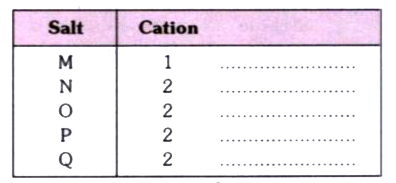On adding KI solution in excess to a solution of CuSO4, we get a precipitate 'P' and another liquor 'M'. Select the correct pair:
P is CuI and M is I2 solution
P is CuI2 and M is I2 solution
P is CuI and M is KI3 solution
P is CuI2 and M is KI3 solution
The correct Answer is:C
To solve the question, we need to analyze the reaction that occurs when potassium iodide (KI) is added to copper sulfate (CuSO₄) in excess.
Step 1: Identify the Reactants
- The reactants in this reaction are potassium iodide (KI) and copper sulfate (CuSO₄).
Step 2: Write the Reaction
- When KI is added to CuSO₄, a reaction occurs. The balanced chemical equation for this reaction is:
4KI+2CuSO₄→2CuI+I₂+2K₂SO₄
Step 3: Identify the Products
- From the balanced equation, we can see that the products formed are:
- Cuprous iodide (CuI), which is a precipitate (denoted as 'P').
- Iodine (I₂), which remains in solution (denoted as 'M').
Step 4: Determine the Precipitate and the Liquor
- The precipitate 'P' formed in this reaction is CuI (cuprous iodide).
- The liquor 'M' consists of iodine (I₂) dissolved in the solution.
Step 5: Select the Correct Pair
- Therefore, the correct pair is:
- Precipitate 'P': CuI (cuprous iodide)
- Liquor 'M': I₂ (iodine)
Final Answer:
The correct pair is:
- Precipitate 'P': CuI (cuprous iodide)
- Liquor 'M': I₂ (iodine)
---
- The reactants in this reaction are potassium iodide (KI) and copper sulfate (CuSO₄).
- When KI is added to CuSO₄, a reaction occurs. The balanced chemical equation for this reaction is:
4KI+2CuSO₄→2CuI+I₂+2K₂SO₄
Step 3: Identify the Products
- From the balanced equation, we can see that the products formed are:
- Cuprous iodide (CuI), which is a precipitate (denoted as 'P').
- Iodine (I₂), which remains in solution (denoted as 'M').
Step 4: Determine the Precipitate and the Liquor
- The precipitate 'P' formed in this reaction is CuI (cuprous iodide).
- The liquor 'M' consists of iodine (I₂) dissolved in the solution.
- Therefore, the correct pair is:
- Precipitate 'P': CuI (cuprous iodide)
- Liquor 'M': I₂ (iodine)
The correct pair is:
- Precipitate 'P': CuI (cuprous iodide)
- Liquor 'M': I₂ (iodine)
Topper's Solved these Questions
- QUALITATIVE INORGANIC ANALYSISBOOK - VK JAISWAL ENGLISHCHAPTER - QUALITATIVE INORGANIC ANALYSISEXERCISE - LEVEL 2
76 Videos
- QUALITATIVE INORGANIC ANALYSISBOOK - VK JAISWAL ENGLISHCHAPTER - QUALITATIVE INORGANIC ANALYSISEXERCISE - LEVEL 3
62 Videos
- PERIODIC PROPERTIESBOOK - VK JAISWAL ENGLISHCHAPTER - PERIODIC PROPERTIESEXERCISE - MATCH THE COLUMN
11 Videos
- s-BLOCK ELEMENTSBOOK - VK JAISWAL ENGLISHCHAPTER - s-BLOCK ELEMENTSEXERCISE - SUBJECTIVE PROBLEMS
2 Videos
Similar Questions
Knowledge Check
On adding ammonia hydroxide solution to a solution of a salt, a dirty green precipitate appears. This precipitate, however, remains insoluble on addition of an excess of ammonia solution. Which metal solution is present ?
ANaBZnCFeDAl
When CuSO4 is added to a solution of ammonia
View SolutionOn heating glucose with Fehling solution. We get a precipitate whose colour is?
View SolutionIn a solution of CuSO4 how much time will be required to
precipitate 2 g copper by 0.5 ampere current?
View SolutionOn adding excess of NH4OH to copper sulphate solution
View SolutionCuSO4 solution reacts with excess of KCN solution to form:-
View SolutionCuSO4 solution reacts with excess of KCN solution to form:-
View SolutionSalts M, N, O, P and Q undergo reactiom (i) to (v) respectively.
Identify the cation present in these salts on the basis of these reaction. Tabulate your answer in the format given below.
1. When sodium hydroxide solution is added to the salt M, and heated strongly a colourless gas with a pungent smell is evolved which turm red litmus paper blue and gives dense white fumes with a moist glass rod with hydrochloric acid.
2. Addition of dilute hydrochloric acid to a solution of N gives a thick white precipitate which is soluble in hot water.
3. When ammonium hydroxide solution is added to the solution of 0 a light blue precipitate is obtained which is soluble in excess of ammonium hydroxide to form an inteme deep blue solution.
4. When ammonium hydroxide solution is added to the solution of P reddish brown (mustard colour) precipitate is obtained which ,is insoluble even in the excess of ammonium hydroxide solution.
5. When sodium hydroxide solution is added to the solution of Q a which coloured gelatinous precipitate is obtained which is soluble in excess of sodium hydroxide to form a clear solution

View Solution
